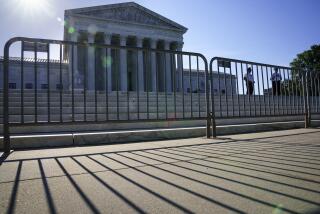God Save This Honorable Court : HOW THE CHOICE OF JUSTICES CAN CHANGE OUR LIVES by Laurence H. Tribe (Random House: $16.95; 179 pp.)
- Share via
The Supreme Court is getting gray. As of this year, the justices will have the oldest average age in the history of the court. And not all of the justices enjoy the best of health. Within the next few years, a President, quite possibly President Reagan, will have the opportunity to appoint justices who may still be sitting on the court well into the next century.
This has not escaped the attention of Laurence Tribe. At age 44, he is a full professor at Harvard Law School; he is the author of a widely respected treatise; he frequently argues cases before the Supreme Court, and he is probably the leading liberal scholar and advocate in the field of constitutional law. Indeed, Tribe will be a front-running candidate for appointment to the court in any future Democratic Administration.
The main point of Tribe’s book is that the Senate should take seriously its duty of giving advice and consent to the nomination of Supreme Court justices.
Tribe argues quite persuasively that the most significant liberal advances of the last three decades have been accomplished by the Supreme Court. Most writers about the court attribute this to judicial activism and broad construction of constitutional provisions, but Tribe does not. He debunks the “myth of the strict constitutionalist.” The Constitution, in Tribe’s view, provides little guidance for modern problems; therefore, every court is an activist court, and the only question is whether its activism is to be conservative or liberal. The minimum task for the Senate is to maintain the current political “balance” of the court.
Tribe also demolishes two other “myths”: that Presidents have been unsuccessful in choosing judicial nominees who support their viewpoints and that the Senate has been a rubber-stamp for presidential nominations. But these myths are so easily demolished because no one who knows the history of the court believes them. Supreme Court appointments have always reflected the political goals of the President and the Senate.
In a work of advocacy, it is not surprising that historical examples are often poorly chosen and inaccurately presented. (Anyone who cares about the historical background should read Henry Abraham’s “Justices and Presidents,” from which Tribe apparently borrowed most of his examples.) This book was written in evident haste and lacks the coherence and careful research one has come to expect in Tribe’s public writings.
But the book performs a valuable public service. No one reading it, whether or not agreeing with Tribe’s ideology, can doubt the political impact of appointments to the Supreme Court. Let the President and the Senate pay heed.
More to Read
Sign up for our Book Club newsletter
Get the latest news, events and more from the Los Angeles Times Book Club, and help us get L.A. reading and talking.
You may occasionally receive promotional content from the Los Angeles Times.










